
Written By Bill Orzell
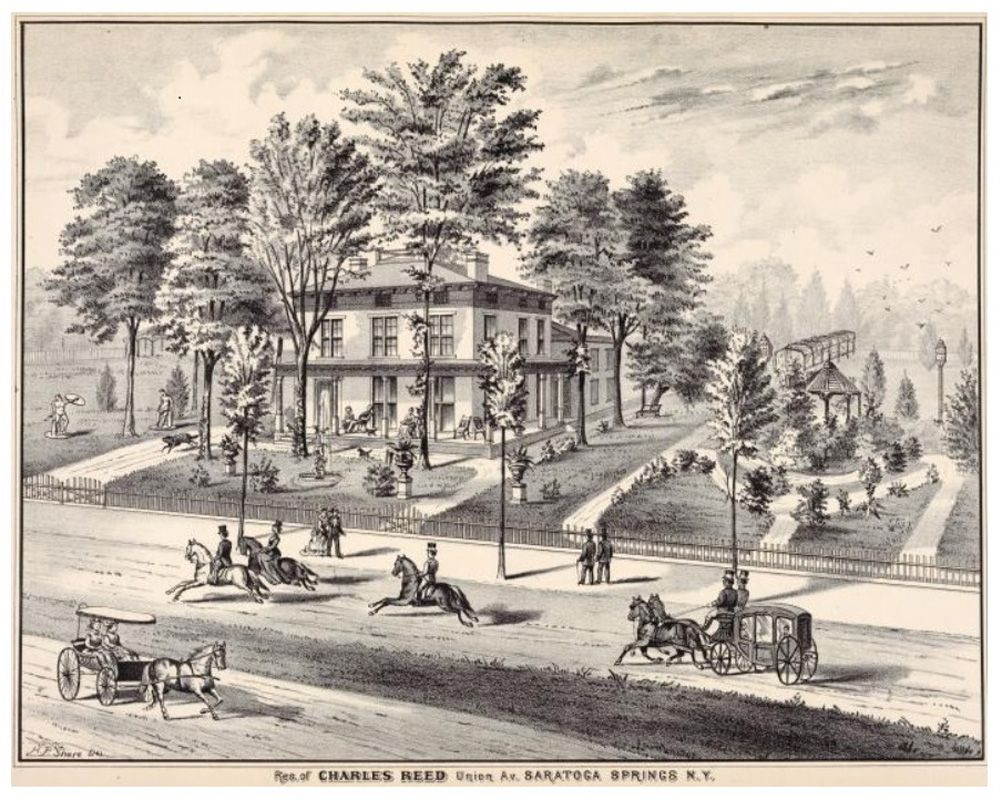
The Reed House on Union Avenue from the Combination Atlas of Saratoga and Ballston, published by J.B. Beers & Co. 1876. On the block between Regent and Clarke (Clark) Streets.
Everyone knows a little city in the foothills of the Adirondacks is possessed by a poetic prestige which is compellingly alluring, and has forged the charming chains which secure Saratoga Springs in its distinct history; the personalities who fashioned these splendid links provide fascination. One person from the halcyon “razor-stropping” days of the Spa was Charles Reed, a Connecticut Yankee who during the Civil War found himself in opportunistic adventures way down south in New Orleans, and later Cuba. After the conflict he made his way to New York, and along with Albert Spencer began operating gaming houses in the Chelsea section of Manhattan. Spencer and Reed’s investment as gamesters grew and they joined with John Morrissey’s operations in New York City and also Saratoga Springs, in a time when the arts counted their best patrons as gamblers, with their betting parlors elegantly adorned.
The Saratoga Association for the Improvement of the Breed of Horses was originally incorporated by eleven sporting gentlemen that operated the race track, along with what was known as the Saratoga Clubhouse, which functioned as a casino in present day Congress Park. As the ranks thinned of shareholders, management changes took place. By the later 1870s the operation was leased to John Morrissey, with Charles Reed and Albert Spencer as his partners. No changes were made in the racing, which continued under the control and authority of the Saratoga Association. The junior partners had an easy synchronicity as Spencer concerned himself with the gaming house, and Reed, who had always had an affinity for Thoroughbred horses, operated the track. After the death of Mr. Morrissey in 1880, Messrs. Reed & Spencer became the lessees of the valuable properties in Saratoga, the dueling ground for seekers of fortune on the track and at the tables.
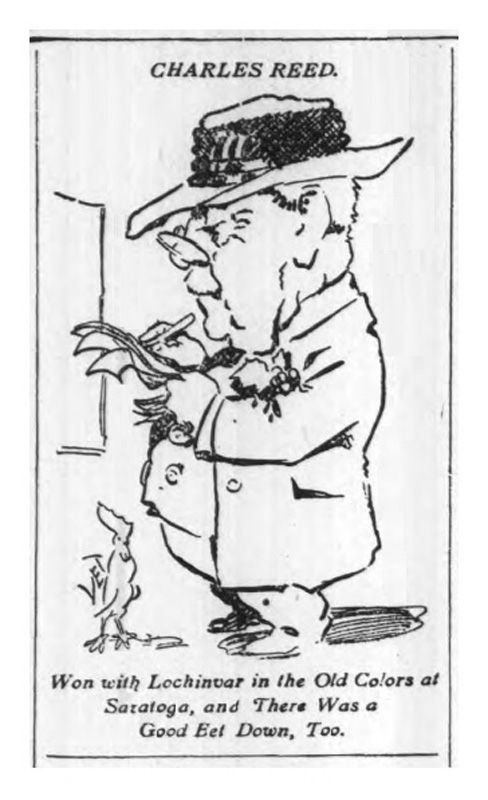
“Uncle Charlie” as he was called by associates, captured in caricature at the track in Saratoga, marking his race program. Jesse Sylvester “Vet” Anderson created this illustration for the New York Morning Telegraph August 24, 1904, and always included his sobriquet as the tail feathers of his rooster signature.
Charles Reed bred horses and they raced in his cherry and blue silks, finding success both on the flats and over the jumps. He saw Saratoga Springs as a garden spot and purchased a home from Cornelius Sheehan on Union Avenue, and the entire block from Regent to Clarke Street. He sought to reconstruct the house in brick, through multiple additions, sparing no expense to build his showplace with some of the furnishings having belonged to Marie Antoinette and Napoleon. Charlie Reed frequently would boast that the house was like a geography lesson when considering where the various components originated. He had an affinity for dogs of all breeds, being the first importer of the French poodle, and fenced his property so his fondness did not disturb the neighbors. Charlie Reed had a booming voice, and he enjoyed fine attire; he was noted for a square bell top hat from his own special block and plaid-checked waistcoat, lavish jewelry and spats. His wife, Ann Jane Reed, was a cigar smoking native of Erin also well known in Saratoga Springs, and said to have coined the term “Horse Haven,” for the practice facility and stables opposite the main track.
Mr. Reed built a breeding farm on Saratoga Lake, near Snake Hill, which he called Meadow Brook Farm, and his sale of yearlings at the Spa in 1881 may have introduced that long-standing splendid tradition. Charles Reed realized there was no better way of keeping spirits up, than by pouring spirits down, and this absolute has been observed from the earliest yearling auctions. Many years later the New York Times would recall Mr. Reed’s first great sale at his Union Avenue home,
“A feature of the first sale of Reed bred yearlings was that the breeder gave a lawn party to prospective bidders before the horses were offered, and champagne made up a large part of the refreshments that were offered to guests. Everybody connected with racing at Saratoga went to the sale, and there was champagne enough to go around and plenty to spare. Not much was spared, however, and one result was that when the Reed horses were put on sale there was congregated about the sales ring the most enthusiastic body of horse fanciers ever gathered at a similar occasion.”
The following year a large number of guests were handsomely regaled by Charles Reed with a dinner spread under a tent on the lawn at his attractive residence on Union Avenue. The ornate bill-of-fare was in character, and served with the hospitality for which the generous turfman was well-known. The auctioneer was none other than the author of the American Stud Book, Colonel Sanders D. Bruce.
Following the 1887 summer racing season Charles Reed decided to focus on his own horse racing and breeding interests, centered at an 1,800 acre breeding farm named Fairview that he purchased in Gallatin, Tennessee. He disposed of his interest in the Saratoga Racetrack and Clubhouse to his longtime partner Albert Spencer. Charlie Reed found great success with his racing stock, and he pursued broodmares and sires from around the world to continue and expand the more profitable pursuit of breeding valuable yearlings for the sales ring.
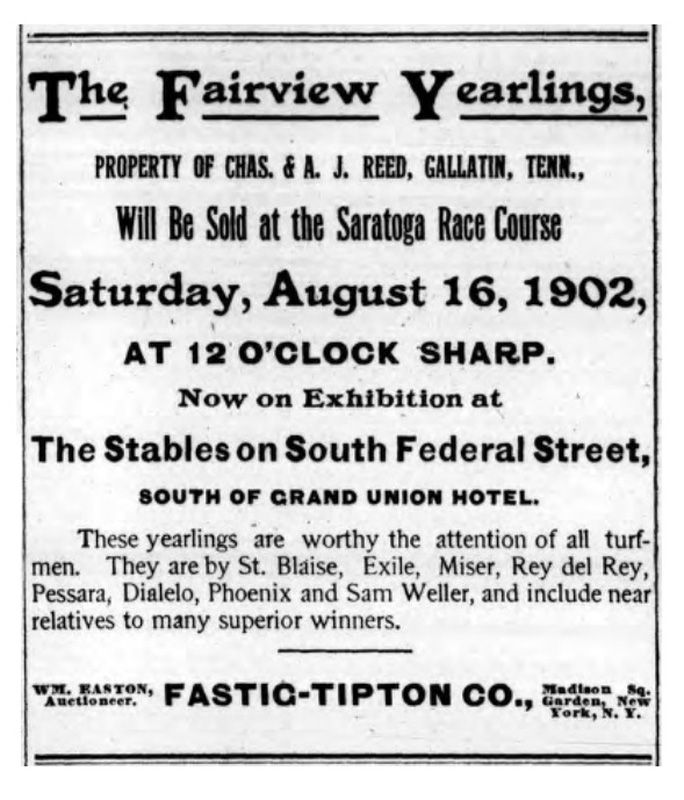
The 1902 vendue which began the annual and much anticipated tradition at the Spa, the yearling auctions, were initiated by Charles Reed, published in the Saratogian August 15, 1902. With Fasig-Tipton as a new player at Saratoga, their corporate identity suffered a typographical error.
A vendue which has long been remembered was held to settle the estate of August Belmont, Sr., to disperse all his horses at auction, conducted by Tattersall’s in New York. Noted auctioneer William Easton conducted the October 1891 event, attended by one of the most notable gatherings of not only prominent turfmen, but also financial brokers and investors ever brought together for such a purpose in America. The feature of this sale would be the eleven year old Epsom Derby winner, St. Blaise, who had already proven himself as a worthy sire. Opposite the pulpit of the auctioneer sat a gallant old sportsman who nonchalantly enjoyed his cigar, casually containing his excitement and his intension. He wore a plaid-checked waistcoat, spats and a square bell topper tilted over a mop of curly locks which had aged to gray. When St. Blaise was led into the sales ring there was only one bid for the noted stallion, but it was a magnificent bid which no one challenged; Charles Reed offered $100,000. Auctioneer Easton, as startled as everyone else in the hall, brought down his gavel, which created a new sales record for turf history, and St. Blaise was relocated to Fairview Stud. Afterwards, asked to explain his betting strategy, Charlie Reed offered, “I earthquaked ‘em, that’s all, just earthquaked ‘em.”
Following the summer race meet in 1894, Charles and Ann Jane Reed decided they would become lessees in their future travels to Saratoga Springs and sold their residence at 116 Union Avenue (house number revisions on Union Avenue would re-identify the structure as #40). Their block from Regent to Clarke Street was divided into eleven parcels, going to three different buyers, with nine parcels going to Edward Kearney, president of the Saratoga Association.
Charles Reed, after the death of Ed Kearney and sale of the Saratoga Race Course by Gottfried Walbaum in 1900 to a consortium chaired by William C. Whitney, made another important contribution to Spa traditions as his sale of yearlings developed. The Daily Racing Form of August 21, 1902 reported,
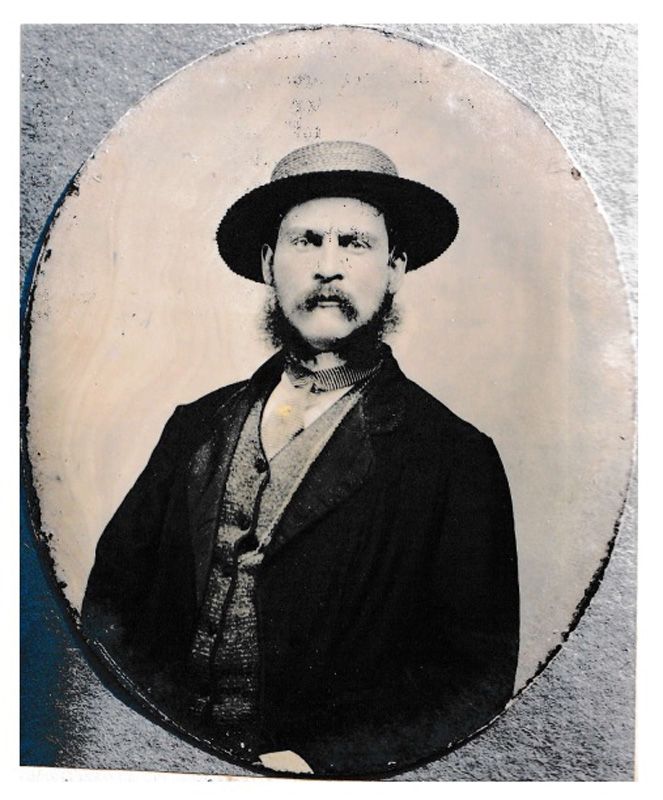
Image of Charles Hanford Reed taken September 10, 1861. Courtesy of the Sumner County (TN) Historian.
“The officers of the Saratoga Racing Association are seriously considering an innovation which may result in bringing to Saratoga the annual yearling sales of the great breeding establishments of Kentucky, Tennessee and California.”
William C. Whitney and his brother officers in the management of Saratoga’s racing enterprise had recently purchased the facility, and were looking to return the track to national prominence after several years of mismanagement by Gottfried “Dutch Fred” Walbaum. The yearling sales were viewed by Mr. Whitney as a successful experiment which could add greatly to the attractiveness of the Saratoga meetings, and the location was the natural regular meeting place of western stables with those of the east. The same DRF article concluded,
“There is nothing to do here of mornings except to drink water, and as water drinking sometimes becomes monotonous, Mr. Whitney believes that all Saratoga would turn out to attend yearling sales. Saratoga has not as many side attractions as New York to divert the attention of buyers.”
Charlie Reed continued to be a fixture in Thoroughbred racing well into the twentieth century, and was a frequent visitor to all the New York tracks every season, even being part of the first opening day at Belmont Park in 1905. Like many turfmen with racing interests in the Empire State, Charles Reed’s operations were damaged and curtailed during the restrictions placed on horse racing when Charles Evans Hughes was elected governor in 1906.
Following Charles Reed’s death at Gallatin, Tennessee in 1914, Schenectady Gazette sportswriter Frank G. Menke wrote,
“Charlie Reed died the other day, but the memory of his fifty years of helpful connection with the turf history of America will live for always. It was Reed who first recognized that Saratoga was one of the garden spots of the world. It was he who boosted most for Saratoga and it was his money that helped to make Saratoga home of the greatest racing centers in the world.”
The former Reed House on Union Avenue had several subsequent owners and while it stood, the present day Alumni House at 28 Union Avenue, and Salisbury House at 48 Union Avenue were built as residences. The Reed House was demolished in 1929, shortly before the Stock Market collapse. Many ornate components were salvaged and distributed to other residences in Saratoga Springs. All of the 11 lots on the block between Regent and Clark Streets, which once belonged to Charles and Ann Jane Reed, were recombined into Skidmore College dormitories, and again divided when the school abdicated its original location.
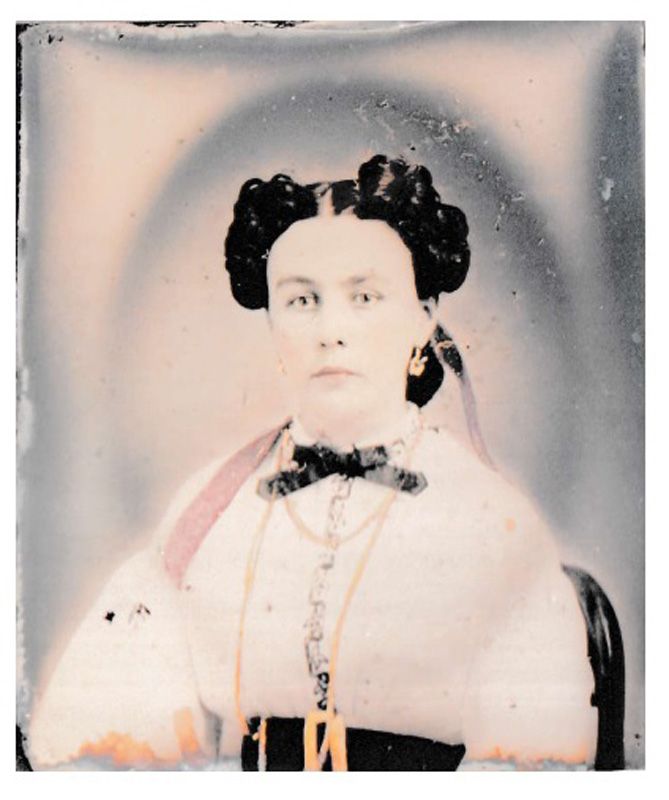
Ambrotype of Ann Jane Reed made March 3, 1864 in Havana, Cuba. Courtesy of the Sumner County (TN) Historian. She coined the term “Horse Haven” for that important Saratoga Springs location.